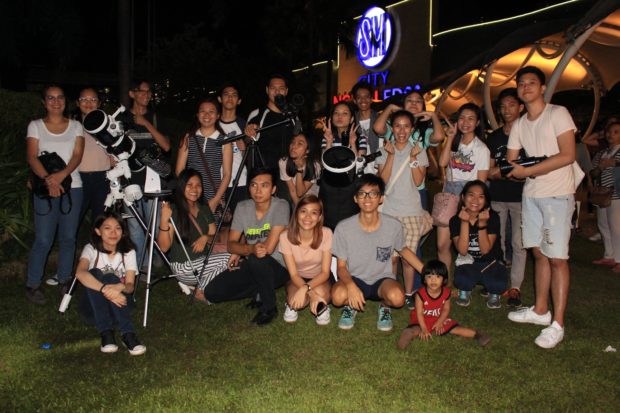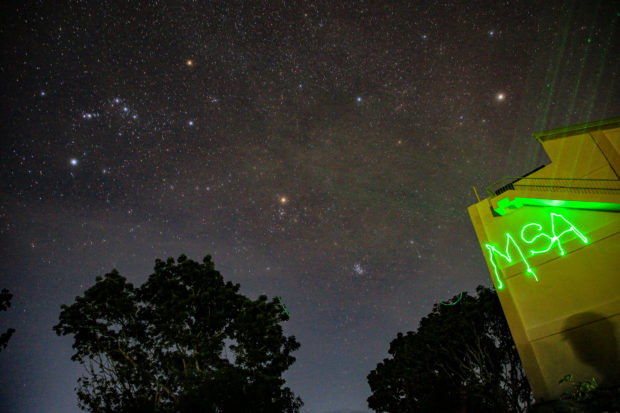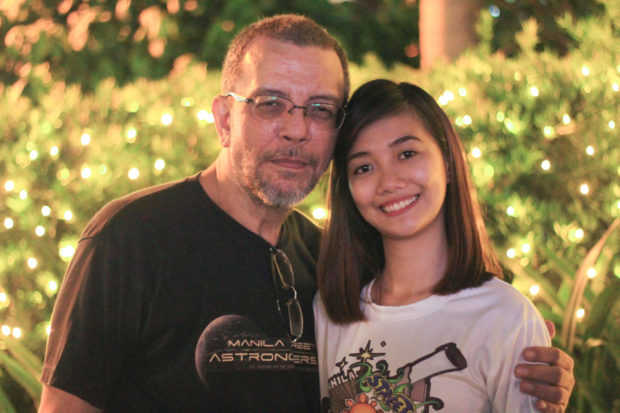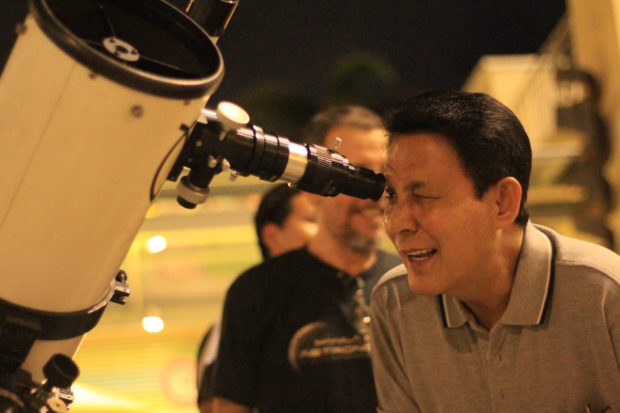‘Street astronomers’ give pandemic-stricken Filipinos much-needed glimpses of outer space

The moon as seen through a telescope. Image: courtesy of Coleen Santos
I did not even have classes that day, but I still took the rush-hour commute to my university. There was no way I would let such a rare opportunity pass.
I have always wanted to take a real, up-close look at the moon – but who doesn’t? Thanks to one group of astronomy enthusiasts, I was finally able to get the chance – and for free.
Joined by friends, curious folks and maybe the bored, I lined up to take a look through large telescopes that offered different glimpses at the moon – and boy, was the commute worth it.
That was back in 2018 – which may seem so long ago from this pandemic-gripped time – but it turns out that the Manila Street Astronomers (MSA) have been conducting free telescope viewings (FTVs) for quite some time.
Now, amid the dire times, just how does the MSA – which is dedicated to sharing the wonders of the cosmos – adjust to a health crisis that prevents such gatherings?
Well, they bring outer space into your homes.

A partial solar eclipse as seen through a telescope. Image: courtesy of Coleen Santos
On telescopes and lockdowns
While the planet is under quarantine, the universe was still kind enough to provide some relief by stirring up some astronomical phenomena.
From the Pink Supermoon in April to Comet Neowise in July, different kinds of spectacles took over the planet’s skies while people are stuck in their humble abodes.
But with all these events happening while social distancing protocols are in place, the MSA had to find new ways to share their (literal) out-of-this-world knowledge.
Coleen Santos, who was among the volunteers during the said FTV at my university, says it took MSA quite a while to decide what to do. In 2018, she was still a college student herself while also being an MSA volunteer. An avid astronomy enthusiast her whole life, she now heads their operations in at least three cities.
However, what is there to “head” amid the lockdown? The MSA initially thought that maybe, they could just sit this pandemic out.
With the so-called “astro-season” spanning October to May, Santos points out that the lockdown that started in March did not force them to immediately adjust to the pandemic.
“At first, we believed that everything would be back to normal by October so we decided to give ourselves a break from our events during the lockdown,” she says.
The MSA then realized that “things aren’t gonna get better soon” and with the then-upcoming June 21 partial solar eclipse, they had to figure something out – so they did. They have so far conducted three lecture-livestreams through Facebook, with the first also being a live viewing session for June’s special event. The latest was last Saturday, Sept. 26, for the “International Observe the Moon Night 2020.”
“We conducted a five-hour program on Facebook where we discussed about eclipses — how it happens, how it works, how to properly view a solar eclipse, and all that,” Santos explains. “After the discussions, we conducted a live viewing of the eclipse while we simultaneously posted photos on our social media accounts.”
Following the pandemic-induced trend of conducting everything online, the MSA was still able to give the public free viewing of an astronomical event, albeit virtually.
“We got pretty good feedback as most of our followers are astronomy enthusiasts who don’t have the proper equipment to view the eclipse, especially that a solar eclipse is pretty dangerous to view if you have no proper equipment as it can lead to permanent eye damage,” the young amateur astronomer explains.

Coleen Santos (sitting in the middle, front) with fellow MSA volunteers. Image: courtesy of Coleen Santos
Despite the MSA being able to adjust to COVID-19, Santos is still eagerly waiting to experience her favorite part of stargazing again, which is doing it with others.
“I’m looking forward to the day that we’d get to connect and partner with schools again so we can interact with students and teach them more about astronomy,” she stresses.
“I hope that one day, MSA would be able to conduct FTVs again so we’d be able to continue sharing the night sky to everyone for free,” Santos adds.

The night sky as seen from Pangasinan on Dec. 1, 2019. Image: courtesy of Coleen Santos
MSA’s Big Bang
Apollo 11’s historic lunar landing is one of Gary Andreassen’s earliest and fondest childhood memories. For someone fortunate enough to have been alive at that time, why wouldn’t it be? He was only 3 years old on July 16, 1969 – a day that for sure inspired millions of future amateur and professional astronomers all over the planet.
Decades later, now an adult working a job that has nothing to do with astronomy, Andreassen’s love for outer space remains.
It was in 2013 when he chanced upon a cheap, plastic telescope at a bookstore and bought it out of a whim. Despite its poor quality, however, Andreassen’s experience with this 800-peso instrument sparked his desire to share his passion with others.
In an interview with INQUIRER.net, Andreassen recalls how his first reaction of seeing the moon with this telescope was the expected “woah!” His reaction right after, however, was what has become the core mission of the group he will then form.
“I have to share this with everybody else!” he recalls telling himself. Around three months later, he bought another telescope, this time a bit bigger and better than his first. Then in 2014, he held the MSA’s first-ever FTV.
Sharing the same story through their Facebook page on Aug. 21, Andreassen borrowed a fitting quote from famous “amateur astronomer” John Dobson: “The true value of a telescope is the number of people who have seen the heavens through it.”
And with that, Andreassen emphasized that “[the] telescopes of Manila Street Astronomers must be worth millions now.”
“I got poorer and poorer buying bigger and better telescopes – but my soul got richer and richer showing the Moon and the planets to more and more people,” he said.
Andreassen moved to Canada in 2017, yet the mission he started in the Philippines goes on. He still aids the MSA back home while conducting FTVs for his new neighbors.
This actually got me wondering – just how do different cultures and nationalities react to objects outside our little planet? How do people from Canada, a space-faring nation, react to looking through a telescope as compared with Filipinos?
Of course, Andreassen had the answer, and perhaps it was the best one that I could ever get.
Despite the thousands of kilometers separating Manila and Alberta, Andreassen said he “found it amazing” that astronomy affects people all the same.
“You could be white, you could be brown, you could be black, you could be yellow, you could be any religion, any color, race, creed – but the sounds of the ‘woah’ and the look on the face, they all look the same… regardless of who or what you are,” he stresses.

MSA founder Gary Andreassen (left) and Coleen Santos. Image: courtesy of Coleen Santos
Pursuing the stars
Like Andreassen, Santos has been fascinated with astronomy ever since she was a child. But it was in high school, upon learning about constellations, when her “love for the night sky really started.”
As if dictated by the universe, the stars were brought closer to Santos herself during one fateful night in 2016. Santos and her family were then just strolling inside a mall in Quezon City. While looking for a place to eat, she suddenly spotted a sight that piqued her interest.
“I saw some signs that say, ‘FREE TELESCOPE VIEWING’ so I lined up, and I was able to view the Moon and Jupiter for the second time in my life,” Santos says.
“That night, I really felt something in me. I wasn’t able to identify what I felt at that time but looking back, I think what it was is actually inspiration,” she adds.
She says that deep inside, she wanted to contact MSA and ask how she “can be one of them,” but was too afraid to do so.
“I was an AB Journalism student and I have very little knowledge about astronomy,” she recalls. “Back then, I thought I had nothing to show this group, I had nothing to contribute, so why would they let me join them?”
Even with these bugging her mind, Santos the following week spotted the MSA again; only this time, she swallowed her fear and asked for the opportunity to become a volunteer. Now, years later, she is among the core group members.
The MSA does not require volunteers to have science degrees or be astronomy experts. You just need to have the heart and the passion for astronomy, and fortunately, Santos had those.

Coleen Santos (front, left) with MSA volunteers and students of Cipriano P. Primicias National High School in Pangasinan. Image: courtesy of Coleen Santos
Sharing outer space
Despite being a relatively young organization, the MSA’s efforts has made it possible for countless Filipinos – no matter their age and state in life – to indulge in the beauty of the cosmos.
Before COVID-19, the group had been conducting events in various locations, including schools, malls and even street corners.
Santos shares that whenever they encounter educators during their FTVs, they would encourage them to invite the MSA to conduct free lectures. “We customize different programs depending on the need and the request of the schools, and we also consider the grade level and amount of students that will be covered by the event.”
The MSA’s reach is quite limited for now. Despite this, some volunteers have still been able to reach faraway provinces such as Baguio and General Santos City. The farthest school they have meanwhile gone to is the Cipriano P. Primicias National High School in Pangasinan.
“We normally entertain invitations from different schools in NCR, but we also accept invitations from provincial schools if the conditions are favorable to our volunteers,” she explains.
Prior to the pandemic, they have been conducting four FTVs a month, two of which were being held in schools.
Doing their part
One of the MSA’s objectives “is not to wait for the people to go to the telescope – it’s to bring the telescope to the people.”
I can attest to this noble goal, as I believe that I will not be able to take that majestic look at the moon to this day if they did not visit my university back then.
Perhaps I may not be exploring the city much – pre-pandemic, of course – but the only FTV my friends and I have been able to participate in is the one hosted by the MSA — and we can only be grateful that they do what they do.
While there are various astronomy groups in the country, the MSA is the only group that focuses on holding FTVs. Andreassen clarifies that this does not make them better, however, as every organization has its own focus.
The MSA, which is not government-recognized, do not ask membership fees from volunteers, yet they still make it possible to do what they do as their passion makes spending their own money all worth it.
Having volunteers from all walks of life, the MSA’s public outreach events likewise do not cater only to one sector of society.

Actor Tirso Cruz III looking through a telescope with Gary Andreassen in the background during an FTV in Alabang. Image: courtesy of Coleen Santos
In their six-year journey, Andreassen’s favorite experience by far happened during one FTV in a poverty-stricken neighborhood in Muntinlupa.
“There were like a few drunken brawls [by] our side while we were setting up the telescopes,” he laughs as he recalls the memorable night.
“It was really scary just going there… baka mamaya biglang itumba ‘tong mga telescope namin ng lasing na mapagtripan kami (maybe some drunken fellow would just suddenly shove our telescope to the ground),” he quips.
As his laughter fades away and adapts a more serious tone, Andreassen emphasizes, “And yet, I think that was the proudest moment – one of my proudest moments.”
“Seeing their reactions when they saw the moon, that was like – that was the sweetest,” a smiling Andreassen says, referring to the street kids that got to peek through their telescopes.
Being able to give such an experience to those who would not likely have bought telescopes themselves, is what MSA is all about. For Andreassen, “that was the best moment ever.”
I understood what he meant when he admitted that astronomy is still underrated in the Philippines, after all, we still got a lot of countrymen who think that pursuing any national interest on space should not be a priority. But he also told me that the MSA will just continue doing their thing nonetheless. He says he wants the MSA to be at the forefront when astronomy becomes big in the country, something I believe our people undoubtedly still deserve, despite the misinformed dismissals.
“We’re just gonna try to help as much as we can; to do our part, to make more and more people – especially the Filipino people – into the sciences and more and more into astronomy, specifically,” he says. “If that helps in any way, that people get encouraged to support the Philippine Space Agency because they have now been made aware of the existence of such… then we would have done our part.” JB
RELATED STORIES:
The sun has started a new solar cycle, NASA confirms
WATCH: NASA releases time-lapse featuring 10 years of the sun